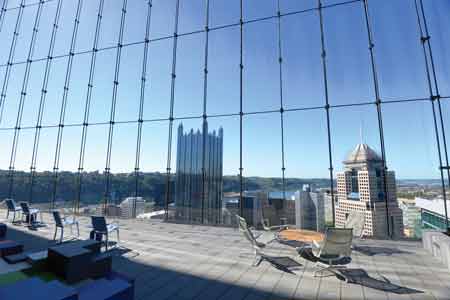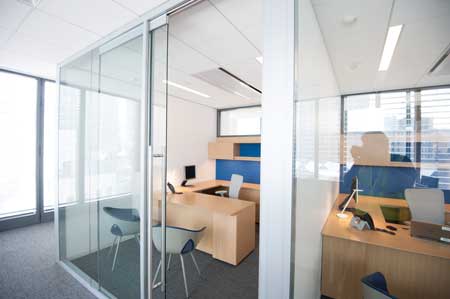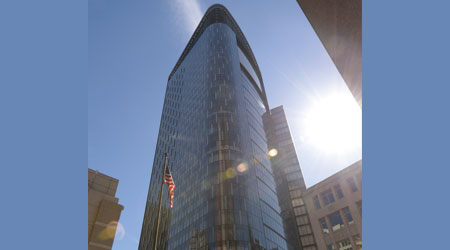Even Most Efficient High-Performance Buildings Require Constant Monitoring, Tweaking
Part 3 of a 5-part article profiling the high-performance PNC Tower in Pittsburgh.
Any large, innovative system requires tweaks and offers surprises once it goes online, and the PNC Tower is no exception. The building, which only achieved full occupancy in January, has been a learning experience for the facility team. “I would say you discover something new every day,” Pease says, “and the design team knew that would happen. We planned for it.” A huge array of sensors and controls allows operators to understand sooner what is happening and adjust, he says.
One surprise during the building’s debut has been the sun’s power. The solar chimney has been working according to plan, but Fusan says he’s been amazed at the amount of solar energy the building can receive even on a cloudy day, which he attributes to the roof design and to the ability of solar energy to penetrate cloud cover.

Caption: The tower’s five-story-high Indoor Park, or atrium, offers fresh air and a panoramic view of downtown Pittsburgh from the 28th floor. The space is supported by a 100-foot curved steel truss.
“Saturday (Feb. 20), we were at about 10 degrees, it was a sunny afternoon, and we were actually getting cooling demands from the southern exposure,” Fusan says. “What’s amazed a lot of us is what you can get out of the sun if you let the sun work for you.” He says the sun has influenced building operations more than he would have guessed, with less need for heating than anticipated, especially on the western and southern sides of the building.
The biggest challenge for facility managers so far has been glare, with too much daylight streaming in in the mornings. Interior roller shades are being installed to further address the issue. A related surprise is the amount of reflected glare from other buildings. Another issue is training PNC employees to close the sliding glass doors, which affects indoor air quality. “People are going home and not closing the doors,” Fusan says. “At the end of the day we’re closing 50, 60 doors.”
Operators have made adjustments to reduce terminal velocity noise at the chilled beams, to tweak air velocity through the building, and to revise opening-and-closing parameters on the poppers.
“Although this building is very complex and very unusual,” Fusan says, “when you look at all the theories that we use here, they’re a hundred years old. Hot air rises — and we’re taking advantage of that. Windows open and close — they have for 100 years — and we’re taking advantage of that. It’s not that there’s a lot of magic per se in the technology; the magic is in the coordination of these systems. And then I’ll admit there are far more moving parts in this building than we have in any other building. But so far our experience with all those moving parts has been good. We had the initial failure rate that you get in anything, but once we got through that, we’re doing pretty well. We have not had a lot of issues.”
Moving Forward
PNC operators say it will take a year’s worth of data to quantify energy savings, though they point out that moving naturally ventilated air through the space without fan energy inevitably means energy savings.
The operations team meets twice a week in “root canal meetings” aimed at discussing, researching, and identifying issues. The discussion system works great, Fusan says. “We’ve had a lot of improvements to what we thought would be our best operating sequence. Hindsight is always 20-20.” He adds, “I’m able to see all the alarms that come up in this building, so I’m very cognizant about how the building is running.”
The team expects to be tweaking the building through next January. “We have discovered things on a day-to-day basis, and but what we really need is a one-year aggregation of all that info — and there’s a lot of information we can gather,” Fusan says. “And then we can look at any major changes to the sequence that will help us run more efficiently.”
The emphasis at the tower is on doing as much maintenance work internally as possible. The operating engineers are trained to deal with nearly anything in the building that might need repair, Fusan says. Those engineers, Finegan adds, were brought into the tower’s design and construction process early on in order to build their knowledge, which is unusual.

Caption: An estimated 91 percent of the tower is lit by natural light, including this office area. Light colors on ceilings and walls reflect natural light onto desks and into the building. Lighting controls moderate overhead lights if natural light is sufficient.
“We’re very early in the game,” Gilmore says, “but I don’t think keeping the tower running for the next 40 years will be any more difficult than any other building because the (operators) will know how to run this building. There may be a few more parts and pieces we’ve got to buy over the years, but when you look at the energy that we’ll save as a result of all those moving parts, it’s a no-brainer. We’re still way ahead of the game.”
Pease says the tower is a building that will get better over time, versus a conventional building that gets commissioned and gradually starts to degrade. The tower will get continually tuned over time, he says. “It’s going to be fairly efficient the first year, but it will get better as we understand how employees are behaving in the building and how that impacts the control sequence. Understanding how the building gets occupied and used will allow the building to get better and better.”
Send comments to ronald.kovach@tradepress.com
Related Topics:


















